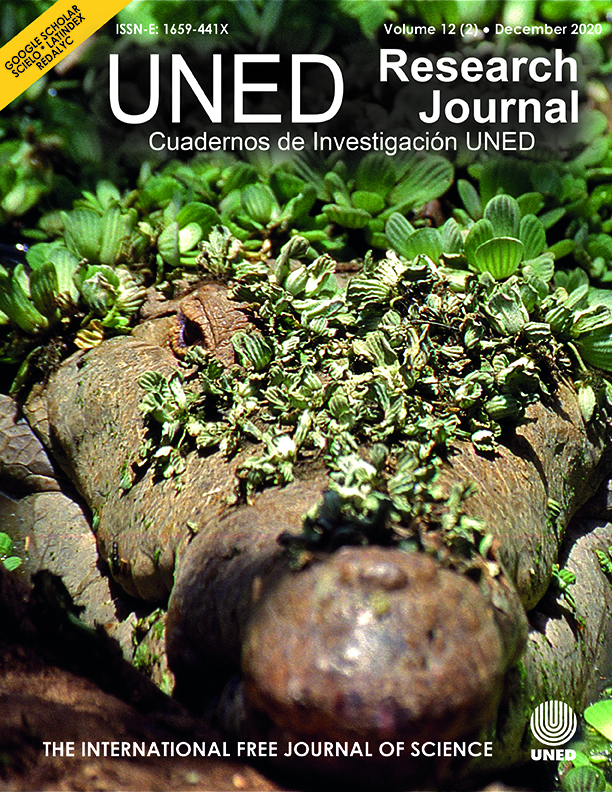Selection parameters for yield in muskmelon (Cucumis melo) under greenhouse conditions
DOI:
https://doi.org/10.22458/urj.v12i2.2935Keywords:
Cucumis melo, Number of fruits per plant, Yield, Pearson correlation, Path analysisAbstract
Introduction: Muskmelon is among Costa Rica’s main agricultural export products, and selection parameters for yield, considering direct and indirect effects, are best studied by path coefficient analysis, which divides correlation coefficients into direct and indirect effect components. Objective: To obtain a Path analysis for greenhouse Muskmelon yield. Methods: we planted the specimens on coconut fiber as substrate, managed with fertigation. The variables were: days to start of harvest (days after transplant-dat), fruit weight (FW, in g), number of fruits per plant (NFP), yield (kg/plant), fruit flesh firmness (N), percentage of total soluble solids (°Brix), equatorial fruit diameter (ED, in mm), polar fruit diameter (PD, in mm), PD/ED ratio, fruit flesh thickness (FFT, in mm), fruit cavity thickness (FCT, in mm), and 2FFT/FCT ratio. Results: Yield showed a positive and highly significant correlation with NFP (r=0,97**), PD/ED ratio (r=0,65**) and PD (r=0,54**). The main positive direct effects on yield were exhibited by NFP (path coefficient-PC=1,05), FW (PC=0,20), PD (PC=0,16), 2FFT/FCT ratio (PC=0,11) and FCT (PC=0,06), while maximum positive indirect effects on yield were exhibited by PD/ED ratio (PC=0,69) and PD (PC=0,48) through NFP. The main negative direct effects on yield were exhibited by PD/ED ratio (PC=-0,19), FFT (PC=-0,15) and ED (PC=-0,05). Conclusion: Under these conditions, number of fruits per plant was the main yield contributing variable.
References
Choudhary, B. R., Fageria, M. S., & Dhaka, R. S. (2004). Correlation and path coefficient analysis in muskmelon (Cucumis melo L.). Indian Journal of Horticulture, 61(2), 158-162.

Feyzian, E., Dehghani, H., Rezai, A. M., & Jalali, M. (2009). Correlation and sequential path model for some yield-related traits in melon (Cucumis melo L.). Journal of Agricultural Science and Technology, 11, 341-353.

Ibrahim, E. A., & Ramadan, A. Y. (2013). Correlation and path coefficient analyses in sweet melon (Cucumis melo var. Aegyptiacus L.) under irrigated and drought conditions. Pakistan Journal of Biological Sciences, 16(13), 610-616.

Kultur, F., Harrison, H. C., & Staub, J. E. (2001). Spacing and genotype affect fruit sugar concentration, yield, and fruit size of muskmelon. Hort Science, 36(2), 274-278.

Mehta, R., Singh, D., & Bhalala, M. K. (2009). Correlation and path analysis in muskmelon. Indian Journal of Horticulture, 66(3), 396-399.

Monge-Pérez, J. E. (2014). Producción y exportación de melón (Cucumis melo) en Costa Rica. Tecnología en Marcha, 27(1), 93-103.

Monge-Pérez, J. E. (2016). Evaluación de 70 genotipos de melón (Cucumis melo L.) cultivados bajo invernadero en Costa Rica. InterSedes, 17(36), 1-41.

Monge-Pérez, J. E., & Loría-Coto, M. (2019). Melón (Cucumis melo L.) cultivado bajo invernadero: correlaciones entre variables. Tecnología en Marcha, 32(1), 134-150.

Rad, M. R., Allahdoo, M., & Fanaei, H. R. (2010). Study of some yield traits relationship in melon (Cucumis melo L.) germplasm gene bank of Iran by correlation and factor analysis. Trakia Journal of Sciences, 8(1), 27-32.

Reddy, B. P., Begum, H., Sunil, N., & Reddy, M. T. (2017). Correlation and path coefficient analysis in muskmelon (Cucumis melo L.). International Journal of Current Microbiology and Applied Sciences, 6(6), 2261-2276.

Shivaprasad, M. K., Vasant, M. G., Halesh, G. K., Buvaneshwari, G., & Vinay, G. M. (2017). Correlation studies in muskmelon for growth, yield and quality attributes. International Journal of Pure & Applied Bioscience, 5(4), 1913-1916.

Tomar, R. S., Kulkarni, G. U., & Kakade, D. K. (2008). Genetic analysis in muskmelon (Cucumis melo L.). Journal of Horticultural Sciences, 3(2), 112-118.
Published
How to Cite
Issue
Section
License
Note: This abstract contains an incorrect copyright due to technical issues. Authors who publish with this journal agree to the following terms: Authors retain copyright and grant the journal right of first publication with the work simultaneously licensed under a Creative Commons Attribution License that allows others to share the work with an acknowledgement of the work's authorship and initial publication in this journal
All journal contents are freely available through a CC BY 4.0 license.
CC BY 4.0 is a Creative Commons: you can copy, modify, distribute, and perform, even for commercial reasons, without asking permission, if you give appropriate credit.
Contents can be reproduced if the source and copyright are acknowledged according to the Open Access license CC BY 4.0. Self-storage in preprint servers and repositories is allowed for all versions. We encourage authors to publish raw data and data logs in public repositories and to include the links with all drafts so that reviewers and readers can consult them at any time.
The journal is financed by public funds via Universidad Estatal a Distancia and editorial independence and ethical compliance are guaranteed by the Board of Editors, UNED. We do not publish paid ads or receive funds from companies.
